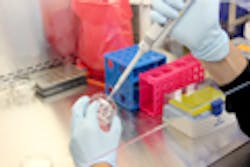Testing gaps remain in addressing GBS infections among infants
One of the biggest threats to neonatal health comes from group B Streptococcus (GBS), which is responsible for more cases of meningitis and sepsis during the first week of an infant’s life than any other agent. In cases where mortality can be prevented, GBS can still lead to profound disabilities later in life. The bacterium is commonly carried by healthy adults and can be passed to newborns from their mothers during delivery. In some countries, as many as four in 1,000 live births are affected by GBS.1
Improvements in detection—including better guidelines and the adoption of nucleic acid-based tests—have led to a significant decrease in the incidence of GBS infections among newborns. In the United States, for example, routine screening of women around the 36th week of pregnancy has made it possible to detect the mother’s GBS colonization status ahead of time and treat GBS-positive mothers with prophylactic antibiotics during labor and delivery. While this has dramatically reduced the number of infants affected, statistics from the Centers for Disease Control and Prevention (CDC) indicate that GBS remains the leading infectious cause of morbidity and mortality in infants born in the U.S.2
There is still much room for improvement in GBS detection, nationally and globally. Many labs use culture tests rather than newer, more accurate molecular tests. Guidelines for routine screening, such as the ones that have been successful in the U.S. and Canada, are still not used in some countries. Even where screening guidelines are available, pregnant women without regular access to healthcare are unlikely to get the benefit of screening. Addressing these gaps in GBS detection would have a significant positive impact on the health of infants around the world.
Screening guidelines
The effects of GBS infections among infants were not discovered until fairly recently. In the 1970s and 1980s, researchers and clinicians began showing that this bacterial strain was associated with symptoms seen in affected babies. By the mid-1990s, enough research and clinical studies had been conducted to convince major medical groups that treating pregnant mothers and infants exhibiting early signs of sepsis with a preventive course of antibiotics for GBS would lead to better health outcomes. The American College of Obstetricians and Gynecologists, the American Academy of Pediatrics, and the CDC all issued recommendations for this approach.
Within the past 15 years, these groups have updated their guidelines to include universal screening for women at 35 to 37 weeks of pregnancy. This program has been credited with the dramatic reduction in infants suffering GBS infections in the U.S., down 27 percent during just the few years following the introduction of universal screening.3
Molecular tests
When screening programs were first launched, culture-based testing was considered the gold standard. More recently, however, several laboratories and diagnostic companies have developed nucleic acid-based tests, which offer a number of advantages.
Repeated studies have shown that nucleic acid amplification tests using enrichment protocols are far more sensitive than culture-based tests, with at least one report demonstrating sensitivities greater than 90 percent for multiple commercially available GBS diagnostics, compared to less than 54 percent for culture testing.4,5 In a high-stakes diagnosis such as GBS, getting a false negative could have dire consequences for the newborn, while a false positive could lead to unnecessary antibiotic treatment. Clearly, it is critical to get an accurate answer to provide optimal healthcare for mother and child.
Advocates of nucleic acid-based assays point to other benefits. Molecular tests also offer faster turnaround time than cultures do, getting results back to physicians more quickly. While it is widely accepted that generating results is not urgent for antenatal GBS detection, it’s worth considering the peace of mind that faster results can bring to anxious expectant mothers. Also, the workflows for these assays tend to be simpler to perform, with less room for error and minimal hands-on time for laboratorians. For all these reasons, more and more laboratories are transitioning their GBS cultures to molecular assays.
Improvement needed
Despite the success of screening programs, there are still many areas where GBS detection can be improved—with many infants’ lives to save along the way. The consistency of screening guidelines is one such area. Recommendations vary by country or region, and some countries have opted for no guidelines at all. In the United Kingdom, some experts believe the recent increase in the incidence of GBS among infants can be attributed to the country’s lack of screening guidelines. Statistics from Public Health England show a 12 percent increase in the number of babies affected by GBS between 2011 and 2015.6 A recent clinical trial there screened 5,000 women; preliminary results indicated an 80 percent decrease in neonatal GBS infections when this approach was used.7
Even in places where screening is routine, successful outcomes have not been evenly distributed. Racial disparities persist, and women without access to standard prenatal medical care typically miss being screened.8 One recent study in the U.S. found that just 67 percent of mothers who delivered full-term babies and 58 percent of mothers with preterm deliveries had been screened for GBS.9 This suggests a real opportunity to improve education among patients and physicians about the importance of getting tested during pregnancy.
Better testing could also make a difference in reducing the incidence of GBS among newborns. While CDC guidelines include both culture and molecular assays for detecting GBS after initial enrichment, a lot of labs still use culture for that step despite strong evidence that molecular assays generate more reliable tests in less time. There is a lingering perception that culture-based tests are less expensive, but many lab directors who factor in the value of their staff time have concluded that these laborious tests are more costly than they appear. If we could eliminate the false negatives associated with culture tests, we could get antibiotic treatment to mothers and babies in greatest need and lessen the number of deaths and disabilities caused by GBS infections.
Moving forward
Although GBS remains a significant threat to newborn health, the good news is that there are still many levers to pull that can drive infection rates down. With a renewed commitment to universal screening and better education to get the word out to the medical community, lab directors, and the public, there is reason to hope that early detection can make a real difference. And as labs adopt modern testing methods with increased sensitivity and specificity, it will be possible to ensure that treatment is available for the infants who are most likely to need it.
REFERENCES
- Marió MJS, Valenzuela I, Vásquez AE, Illanes SE. Prevention of early-onset neonatal group B streptococcal disease. Rev Obstet Gynecol. 2013;6(2):63-68.
- Verani J, McGee L, Schrag S. Prevention of perinatal group B streptococcal
disease – revised guidelines from CDC, 2010. MMWR. 2010;59(RR10);1-32. - Phares CR, Lynfield R, Farley MM, et al. Epidemiology of invasive group B streptococcal disease in the United States, 1999-2005. JAMA. 2008;299(17):2056-2065. doi:10.1001/jama.299.17.2056.
- Brown HL, Ahmadzia HK, Heine RP. GBS screening: an update on guidelines and methods. Contemporary OB/GYN. July 1, 2013.
- Miller SA, Deak E, Humphries R. Comparison of the AmpliVue, BD Max System, and illumigene molecular assays for detection of group B Streptococcus in antenatal screening specimens. J Clin Microbiol. 2015;53(6):1938-1941.
- Mortimer C. One baby dies every two weeks from a preventable infection in
England. Independent. March 5, 2017. http://www.independent.co.uk/life-style/health-and-families/health-news/baby-health-nhs-infection-group-b-streptococcus-neonatal-care-sepsis-testing-a7611951.html. - London North West Healthcare NHS Trust. Pilot shows that screening mothers for group B strep (GBS) saves babies. London North West Healthcare NHS Trust. March 11, 2015. http://www.lnwh.nhs.uk/about-us/news-and-media/latest-news/pilot-shows-that-screening-mothers-for-group-b-strep-gbs-saves-babies/.
- Centers for Disease Control and Prevention. Trends in perinatal group B streptococcal disease — United States, 2000—2006. MMWR. 2009;58(05);109-112.
- Stoll BJ, Hansen NI, Sánchez PJ, et al. Early onset neonatal sepsis: the burden of group B streptococcal and E. coli disease continues. Pediatrics. 2011;127(5):817-826. doi:10.1542/peds.2010-2217.
Anjana Bhattacharya, PhD, serves as Global Product Manager for Women’s Health at Luminex, which recently received FDA clearance for its new ARIES GBS assay.
Sherry Dunbar, PhD, serves as Senior Director of Global Scientific Affairs at Luminex.

